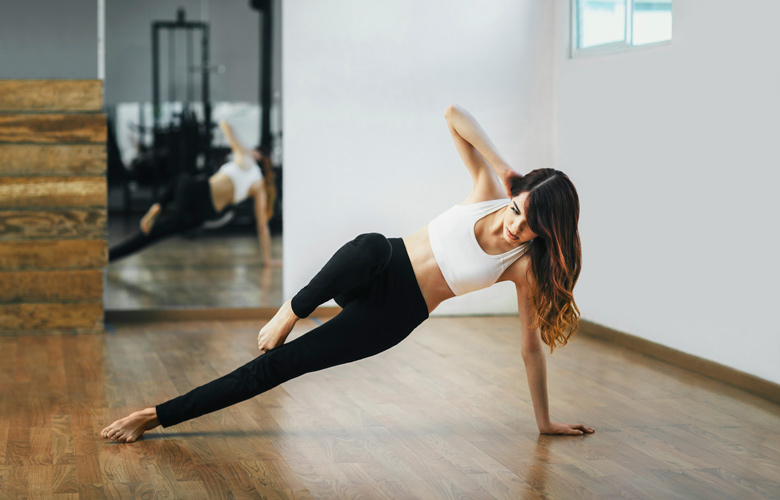Let’s be real: A lot of us feel like heifers when we first start running. We may not feel pretty, but boy, do we feel accomplished: Every step is like one giant step for the history books. Every mile deserves a cookie (or three).
But eventually the steps become more routine, and the hefty feeling gives way to a feeling of lightness. Until one day, you strip off your cow-print onesie and reveal to an adoring public (aka: the nosy neighbor who always waters his lawn at 6:30am) that you are not just a runner: You are a gazelle, nothing but muscle, floating through the air like a sheet of Snuggle fabric softener on a breezy spring day.
That is, until you realize that even gazelles can’t be protected from the most dreaded predator known to runners: the Evil Plateau. (Houston, we have a problem…)
Congratulations: you run! But could you run better? Faster? More efficiently? Yes!
But how? The answer is cross training. And by that, I mean: adding strength exercises and other conditioning workouts to round out your cardiovascular routine. Not only do you look really cool when you actually have triceps to flex as you pump gas, cross training has many practical benefits.
First of all, running relies disproportionately on a limited number of muscles in the legs. Endurance training overworks certain muscles and joints and underutilizes others. The repetitive motion in running is a recipe for disaster unless you mix it up. By cross training, you are not only giving your primary movers (quads) a much-needed rest, adding strength exercises helps to develop supporting muscle groups, like the hamstrings, calves, and the ever-fashionable glutes. Believe it or not, buns of steel aren’t just valuable assets for Instagram models hawking detox tea: having a strong backside propels you forward and balances out your overworked quads.
Not to mention, strength training is the only way to tighten the torso and arms, which are often out-of-mind but not exactly out-of-sight. Let’s face it: You can have model running form, but you’re going to want to think twice about sharing a photo at the finish line when your arms are flappin’ in the breeze like the Texas flag in a tornado. Toned, firm arm muscles are the perfect way to showcase your new running tank, or vice versa. Beyond vanity, it’s also advisable to strengthen the arms, back, and chest for functional reasons: a strong upper body improves posture and the efficiency of your stride.
If you are a swanky NYC bartender, think of cross training as the martini shaker of your training regimen. Maybe you like serving gin (running). Technically, you can serve it straight, and for days on end. But you’re probably going to attract a much livelier party when you start shaking things up a bit and adding various colors, tastes, and textures to the mix.
You never want to drink too much straight gin, trust me.
Speaking of, you know how people warn you about having too much of a good thing? Well, they were right. Too much of a good thing (running) leads to too much of a crippling thing (injuries) when you’re not protecting your joints and strengthening the muscles surrounding them.
Cross training significantly lowers your chances of injury by strengthening your core, and this is the key to staying as injury-free as possible. The stronger your core, the stronger your running. As they say in the ‘hood (my neighborhood running meetup), you ain’t a baller (star runner) if you ain’t ballin’ (skilled on the stability ball). Hit the mats twice a week for core work, and you’ll be rollin’ with the cool kids in no time. (I like to use Jason Fitzgerald’s 13 core exercises as a guide. For a quick tutorial, I also like this video posted by Julie Hanlon.)

Still need more reason to cross train? Be honest. Unless you’re easily amused by the scramble of morning cockroaches scurrying across your path at 5:00am, running every day can get boooooring: same route, same playlist, same pounding on the same pavement. Don’t even get me started on the same post-workout selfie. If you’re a wedding DJ, think of cross training as your turntable. You wouldn’t play YMCA on repeat without mixing in some Michael, some Janet (Miss Jackson, if you’re nasty), and a little Bone, Thugs & Harmony. At the very least, hitting the gym a few times a week gives you a well-deserved change of scenery (and full-length mirror selfies for maximum exposure).
And in case you think you’re invincible, allow me to remind you that sometimes the unthinkable happens: God forbid you injure yourself from running (yes, even gazelles do that from time to time… sadly). Have no fear! Cross training helps you maintain your metabolism during an unexpected off-season, especially if you’ve built up a consistent routine over time. Let your injury rest, but keep your cardio game strong by transitioning to a stationary bike, elliptical, or swimming pool. Switching up your cardio to include lower-impact training helps reduce the risk of injury anyway, and it also prevents you from losing your mojo – your forward momentum – if disaster strikes. Don’t be the runner who hurts her knee only to throw in the towel and drown her sorrows in cookies and gin. Cross training keeps you in the mindset of consistent training, using different exercises, so you can maintain your fitness while you recover.
Cross training may seem like a huge commitment when you’re already running 25 miles a week and drinking Diet Snapple at one of your four kids’ soccer games for 56 hours a week, but it’s manageable. A little bit of cross training can go a long way. Eventually, your running routine will become more efficient, and you should be able to reap much greater benefits without having to run as long.
Which, by the way, leaves you more time to celebrate your successes and less time cursing your latest knee injury. Cheers!
Find more health and fitness tips by following this heifer on twitter @MelissaKahn7 and on her facebook page Run, Heifer, Run!




